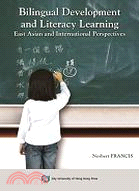商品簡介
With a broad survey of research advances drawing from recent investigations, this book will provide non-specialist readers with examples of how the relevant concepts might be applied to practical problems-age of acquisition effects in first and second language development; analysis of language attrition and asymmetries of different kinds; issues of componentiality (or modularity); bilingual and second language literacy; and the discussion of an important debate in second language acquisition theory and practice.
Bilingual development and literacy learning is intended for practitioners in the field of second language education, administrators and policy makers, and pre-service teachers (upper division and graduate level). In addition, students and specialists in allied fields interested in the key theoretical concepts will find it useful, including in the cognitive sciences in general and sociolinguistics. A detailed glossary is included for readers new to the study of bilingualism and second language learning.
作者簡介
Norbert FRANCIS is Professor of Bilingual and Multicultural Education in the College of Education at Northern Arizona University.
序
In East Asia, as in all regions of the world, second language learning and bilingualism have always been important academic objectives, as far back in history as is possible to record events reliably. But only until more recently have these objectives, including first and second language literacy, been within reach of the broad majority of learners enrolled in school. In the not too distant past, the possibility of attaining bilingualism of this kind had been the privilege of a select few. We could say that today it is still restricted to a fortunate minority; but new conditions have laid the groundwork for changing this state of affairs. Globalization is one of the reasons. Digital technology is another.
Without a doubt, the growing attention to research about different kinds of bilingualism is related to the rapidly growing interest in learning English, evidenced in all but the most isolated societies. Of course, English has not always been in this position. Historically, other languages have served the function of lingua franca across borders and cultures: each in its time, Arabic and Latin in the lands of the Mediterranean and Europe, the languages of the great indigenous empires of the Americas, Chinese throughout East Asia, to mention only a few examples. Today, however, the potential and promise of intercultural communication is different: the “franca” aspect of the current international language of wider communication is global in the true sense, for the first time in history. At the same time, we should not forget that around the world a number of regional lingua francas are also expanding, all of this making the scientific study of bilingualism more important than ever before.
Increasingly, learners face complex and demanding language learning objectives; and choices about major commitments to language learning that are not always optional. This is because the relationships among the national, regional and international languages in each country, and in each community of speakers, are complex and demanding in the same proportion. Complicating matters of this developing bilingualism and multilingualism is the parallel pressure on many languages resulting in their displacement, by an expanding language, and even in their extinction. Often, learning a second language results in losing proficiency in one’s first language. Related to this phenomenon of “learning and forgetting,” is the common outcome of bilingualism in which there is an imbalance in proficiency between one language system and the other. This kind of unequal distribution of competence and ability, in fact, is the most common outcome of bilingual development and second language learning. Understanding these different kinds of language interaction is important for fields of study such as linguistics and psychology and for resolving a number of practical problems in education, to take one example.
One may ask: what is special about bilingualism and literacy in East Asia that it came to be included in the subtitle of this book? In regard to the interaction between two grammatical systems (reading and writing aside for now), and the way that young children acquire them to become bilingual, and the way that adults learn second languages, there is nothing peculiar in the languages of East Asia. There is probably nothing exceptional in this case, from a cognitive point of view, compared to bilingual development in any other part of the world. Rather, it is in the domain of literacy where cross-language/cross-writing system and bilingual/biliterate comparisons are truly interesting. Here it is fair to say that the contrasts among the writing systems in question are exceptional in some important ways. The morphosyllabic characters of Chinese writing, incorporated into and adapted by Japanese writing, have no parallel in any modern orthographic system. They may not have any other true historical parallel either (although this claim is likely to be controversial). Most interesting, however, is the suggestion by recent research that despite the differences in the design of writing systems, common processes of literacy learning and use are shared across all literate cultures.
Today, in part because of the speed and efficiency of word processing, and the rapidly increasing access to it by literacy learners, new interest has emerged among linguists and psychologists in the comparison among writing systems. In the not too distant past, access to portable computers was also the privilege of a select few. How do both native speakers and second language beginners learn the morphosyllabic system, how are the subcomponent skills represented mentally, and how are they put to use in performance (e.g., in terms of comparisons and contrasts with alphabetic systems)? In bilingualism and biliteracy, what are the interfaces, mechanisms of transfer, and mutual influences among systems and subsystems? What aspects of literacy knowledge and processing are the same across orthographies, and which aspects are different? In short, the research problems in these areas are unique and special.
Other aspects of bilingualism and literacy addressed in the coming chapters are not specific to any language or writing system. These correspond to the “international perspectives” in the title. In fact, we should be wary of arguments about language and writing that emphasize at every turn particular and peculiar, culture-bound and “local,” and highly context-dependent properties. Alongside exceptional and unique aspects of literacy ability there is reason to assume universal foundations as well.
Two aspects of bilingualism and multilingualism, both related to the notion of uneven development mentioned above, are especially important from the language policy and planning point of view because they involve issues of social inequality.
1. Speakers of minority languages and speakers of national languages face different, in many ways unequal, requirements, opportunities and conditions of use, for example: knowledge of a language that is optional versus obligatory, access to resources tied to languages of wider communication, prospects of the very survival of a community language into future generations.
2. For many minority language students who have not yet learned the national or official language, disproportionately unfavorable learning conditions result, on average, in reduced attainment of academic language objectives in school (literacy above all). A factor that contributes to these unfavorable conditions could be the mismatch between the language of instruction in school and the language that children understand. For example, some children learn how to read and write in the language they understand completely; others face the challenge of literacy learning in a language that they understand incompletely, or not at all.
This book is not about inequality in society and the unequal distribution of language learning resources, and offers no direct solutions for policy makers on this score. But the linguistic/cognitive research problems of imbalance and asymmetry (in the bilingual mind) are important to discuss because they are part of the solution.
My sincerest thanks are owed to colleagues and friends for their valuable consultations, critical comments and suggestions, and interesting discussions on the topics in this book: Kerim Friedman, Scott Hadley, Xue-ping Hu, Kent Johnson, Panay Kumod and the students and faculty of the College of Indigenous Studies at the National Dong Hua University, Melissa Shih-hui Lin, Judith Oller Badenas, Akiyo Pahalaan (Tung-Chiou Huang), Charles Perfetti, Jiang Xia, Jin Xue, and especially Chih-Hsiung Tu for his help in analyzing the writing sample in Chapter 5.
Thank you to Natalia and Zoraida for the interesting discussions on a number of the important topics in Chapters 5, 6 and 7. I am especially grateful for the many helpful comments and suggestions offered by managing editor Edmund Chan and anonymous reviewers of earlier versions of the final manuscript.
Acknowledgement is granted to the following publications. Portions of earlier versions of chapters 2, 3, 4, 5, 6, 7 and 8 appeared in Applied Linguistics, International Journal of Bilingualism, Journal of Child Language, Language in Society, Language Learning, Language Sciences, Tamkang Studies of Foreign Languages and Literatures, and proceedings from symposia on English teaching published by the English Teachers Association of the Republic of China.
目次
2. Balanced and imbalanced bilingualism
3. Bilingual development in exceptional circumstances
4. Bilingual literacy and comparative research on writing systems
5. Self-correction? Negative evidence in second language literacy learning
6. Corrective feedback in language learning
7. The foundation of immersion education-Integration of language and content
8. Studies of bilingualism for further study
9. Research problems that still have not been solved-response to The Taipei lectures
主題書展
更多主題書展
更多書展本週66折
您曾經瀏覽過的商品
購物須知
為了保護您的權益,「三民網路書店」提供會員七日商品鑑賞期(收到商品為起始日)。
若要辦理退貨,請在商品鑑賞期內寄回,且商品必須是全新狀態與完整包裝(商品、附件、發票、隨貨贈品等)否則恕不接受退貨。

























